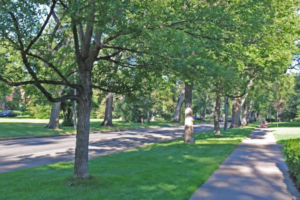In mid-June, the City of Denver confirmed the presence of the emerald ash borer (EAB)…
PLANT THIS, NOT THAT
 Hey, we get it – it’s easy to think “the more the merrier” when it comes to trees. But planting any tree in the public right-of-way (areas between the curb and sidewalk or next to the street), isn’t always good for the future of our urban canopy.
Hey, we get it – it’s easy to think “the more the merrier” when it comes to trees. But planting any tree in the public right-of-way (areas between the curb and sidewalk or next to the street), isn’t always good for the future of our urban canopy.
In fact, some trees can be problematic there. The silver maple is one of those trees. As they mature, these trees become tricksters because they tend to decay from the inside out. Imagine if you will, a tree that’s 30” in diameter, looks great – with lots of leaves – but is hollow inside. Now imagine that tree over the sidewalk or the curb, and the harm it could bring if it were to fall. But the silver maple isn’t the only species facing challenges in Colorado. Read on to learn more about approved street trees, unpermitted street trees and those that fall somewhere in-between.
Get planting!
The approved street tree list for Denver’s public rights-of-way includes trees that, when given proper and consistent maintenance, including supplemental irrigation, proper pruning and mulching, will be assets to Denver’s urban canopy because of their ability to thrive in our climate. Trees not included on this list may not be planted in the public right-of-way (as a street tree) without express permission from the Office of the City Forester. Here are a couple tips to help you plant it right:
- When possible, obtain trees that have been grown from a local seed source. Locally grown trees will be adapted to our area’s highly variable, and often harsh, growing conditions.
- If locally grown trees cannot be obtained, source from locales that have similar growing conditions to our area (precipitation, soil pH, high/low temperatures, etc.)
- Review these basic tips about planting a new tree.
- Email forestry@denvergov.org to get your free tree-planting permit!
Right-of-way? More like wrong-of-way.
Most of the trees listed below tend to develop structural issues. Others create obstructions in various ways. All of them are not welcome in the right-of-way. Per Denver Forestry Rules and Regulations, the following trees may not be planted in the public right-of-way:
- Any of the poplar (Populus) species including cottonwoods and aspens
- Any of the willow (Salix) species
- Boxelder (Acer negundo)
- Siberian elm (Ulmus pumila)
- Multi-stemmed trees
- Weeping and pendulous trees
- Evergreens
Hit pause on these . . . for now.
Other trees – for reasons such as insects, overplanting, invasiveness or structural issues – are currently under a moratorium for planting in the public right-of-way, including:
- Ash (Fraxinus) species, due to the threat of emerald ash borer (EAB)
- Walnut (Juglans) species
- Silver maple (Acer saccharinum)
- Autumn Blaze / Freeman maple (Acer x freemannii)
- Sunburst honeylocust (Gleditsia triacanthos inermis ‘Sunburst’)
- Bradford pear (Pyrus calleryana ‘Bradford’)
- Mulberry (Morus) species
- Russian-olive (Elaeagnus angustifolia)
- Tree-of-heaven (Ailanthus altissima), invasive, structural issues and due to the threat of the spotted lanternfly
If you see a tree excluded from the above list, it may be permitted on a case-by-case basis. Contact the Office of the City Forester at forestry@denvergov.org or 720-913-0651 for details, site inspections and planting permits. As always, we depend on the eyes and ears of the tree loving community to keep us informed.
